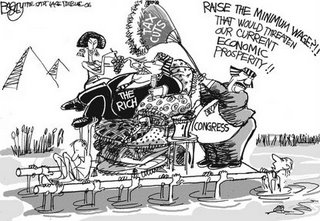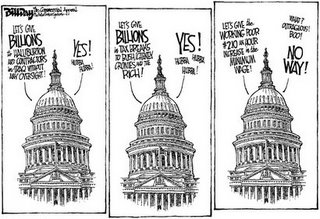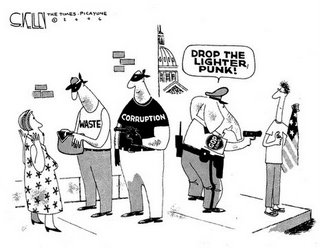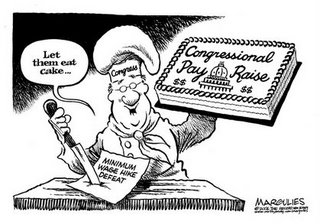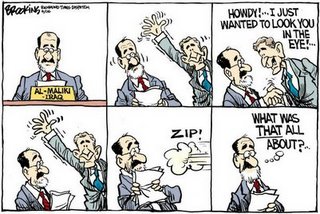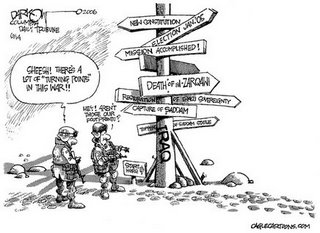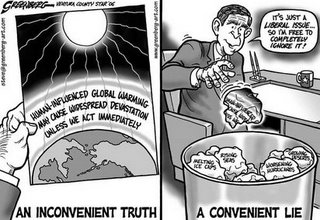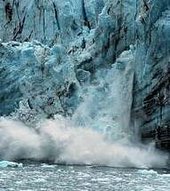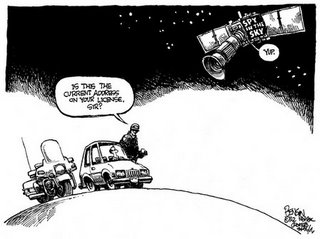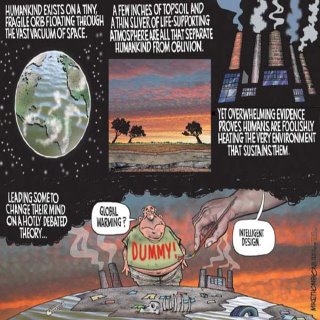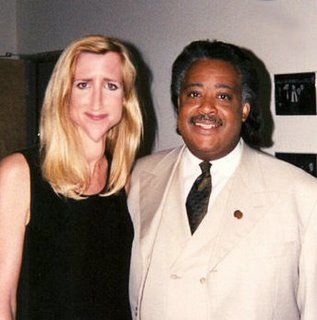Politics, Environment, Current Events and Cinema----------------------------------------CLICK ON ANY IMAGE TO ENLARGE !!!!!!!!!!!!
Tuesday, June 27, 2006
Monday, June 26, 2006
Thursday, June 22, 2006
EARTH'S TEMP MAY BE AT 2,000-YEAR HIGH
By JOHN HEILPRIN, Associated Press Writer1 hour, 39 minutes ago
It has been 2,000 years and possibly much longer since the Earth has run such a fever. The National Academy of Sciences, reaching that conclusion in a broad review of scientific work requested by Congress, reported Thursday that the "recent warmth is unprecedented for at least the last 400 years and potentially the last several millennia."
A panel of top climate scientists told lawmakers that the Earth is heating up and that "human activities are responsible for much of the recent warming." Their 155-page report said average global surface temperatures in the Northern Hemisphere rose about 1 degree during the 20th century.
This is shown in boreholes, retreating glaciers and other evidence found in nature, said Gerald North, a geosciences professor at Texas A&M University who chaired the academy's panel.
The report was requested in November by the chairman of the House Science Committee, Rep. Sherwood Boehlert (news, bio, voting record), R-N.Y., to address naysayers who question whether global warming is a major threat.
Last year, when the House Energy and Commerce Committee chairman, Rep. Joe Barton (news, bio, voting record), R-Texas, launched an investigation of three climate scientists, Boehlert said Barton should try to learn from scientists, not intimidate them.
Boehlert said Thursday the report shows the value of having scientists advise Congress.
"There is nothing in this report that should raise any doubts about the broad scientific consensus on global climate change," he said.
Other new research Thursday showed that global warming produced about half of the extra hurricane-fueled warmth in the North Atlantic in 2005, and natural cycles were a minor factor, according to Kevin Trenberth and Dennis Shea of the National Center for Atmospheric Research, a research lab sponsored by the National Science Foundation and universities. Their study is being published by the American Geophysical Union.
The Bush administration has maintained that the threat is not severe enough to warrant new pollution controls that the White House says would have cost 5 million Americans their jobs.
Climate scientists Michael Mann, Raymond Bradley and Malcolm Hughes had concluded the Northern Hemisphere was the warmest it has been in 2,000 years. Their research was known as the "hockey-stick" graphic because it compared the sharp curve of the hockey blade to the recent uptick in temperatures and the stick's long shaft to centuries of previous climate stability.
The National Academy scientists concluded that the Mann-Bradley-Hughes research from the late 1990s was "likely" to be true, said John "Mike" Wallace, an atmospheric sciences professor at the University of Washington and a panel member. The conclusions from the '90s research "are very close to being right" and are supported by even more recent data, Wallace said.
The panel looked at how other scientists reconstructed the Earth's temperatures going back thousands of years, before there was data from modern scientific instruments.
For all but the most recent 150 years, the academy scientists relied on "proxy" evidence from tree rings, corals, glaciers and ice cores, cave deposits, ocean and lake sediments, boreholes and other sources. They also examined indirect records such as paintings of glaciers in the Alps.
Combining that information gave the panel "a high level of confidence that the last few decades of the 20th century were warmer than any comparable period in the last 400 years," the academy said.
Overall, the panel agreed that the warming in the last few decades of the 20th century was unprecedented over the last 1,000 years, though relatively warm conditions persisted around the year 1000, followed by a "Little Ice Age" from about 1500 to 1850.
The scientists said they had less confidence in the evidence of temperatures before 1600. But they considered it reliable enough to conclude there were sharp spikes in carbon dioxide and methane, the two major "greenhouse" gases blamed for trapping heat in the atmosphere, beginning in the 20th century, after remaining fairly level for 12,000 years.
Between 1 A.D. and 1850, volcanic eruptions and solar fluctuations were the main causes of changes in greenhouse gas levels. But those temperature changes "were much less pronounced than the warming due to greenhouse gas" levels by pollution since the mid-19th century, it said.
The National Academy of Sciences is a private organization chartered by Congress to advise the government of scientific matters.
__
It has been 2,000 years and possibly much longer since the Earth has run such a fever. The National Academy of Sciences, reaching that conclusion in a broad review of scientific work requested by Congress, reported Thursday that the "recent warmth is unprecedented for at least the last 400 years and potentially the last several millennia."
A panel of top climate scientists told lawmakers that the Earth is heating up and that "human activities are responsible for much of the recent warming." Their 155-page report said average global surface temperatures in the Northern Hemisphere rose about 1 degree during the 20th century.
This is shown in boreholes, retreating glaciers and other evidence found in nature, said Gerald North, a geosciences professor at Texas A&M University who chaired the academy's panel.
The report was requested in November by the chairman of the House Science Committee, Rep. Sherwood Boehlert (news, bio, voting record), R-N.Y., to address naysayers who question whether global warming is a major threat.
Last year, when the House Energy and Commerce Committee chairman, Rep. Joe Barton (news, bio, voting record), R-Texas, launched an investigation of three climate scientists, Boehlert said Barton should try to learn from scientists, not intimidate them.
Boehlert said Thursday the report shows the value of having scientists advise Congress.
"There is nothing in this report that should raise any doubts about the broad scientific consensus on global climate change," he said.
Other new research Thursday showed that global warming produced about half of the extra hurricane-fueled warmth in the North Atlantic in 2005, and natural cycles were a minor factor, according to Kevin Trenberth and Dennis Shea of the National Center for Atmospheric Research, a research lab sponsored by the National Science Foundation and universities. Their study is being published by the American Geophysical Union.
The Bush administration has maintained that the threat is not severe enough to warrant new pollution controls that the White House says would have cost 5 million Americans their jobs.
Climate scientists Michael Mann, Raymond Bradley and Malcolm Hughes had concluded the Northern Hemisphere was the warmest it has been in 2,000 years. Their research was known as the "hockey-stick" graphic because it compared the sharp curve of the hockey blade to the recent uptick in temperatures and the stick's long shaft to centuries of previous climate stability.
The National Academy scientists concluded that the Mann-Bradley-Hughes research from the late 1990s was "likely" to be true, said John "Mike" Wallace, an atmospheric sciences professor at the University of Washington and a panel member. The conclusions from the '90s research "are very close to being right" and are supported by even more recent data, Wallace said.
The panel looked at how other scientists reconstructed the Earth's temperatures going back thousands of years, before there was data from modern scientific instruments.
For all but the most recent 150 years, the academy scientists relied on "proxy" evidence from tree rings, corals, glaciers and ice cores, cave deposits, ocean and lake sediments, boreholes and other sources. They also examined indirect records such as paintings of glaciers in the Alps.
Combining that information gave the panel "a high level of confidence that the last few decades of the 20th century were warmer than any comparable period in the last 400 years," the academy said.
Overall, the panel agreed that the warming in the last few decades of the 20th century was unprecedented over the last 1,000 years, though relatively warm conditions persisted around the year 1000, followed by a "Little Ice Age" from about 1500 to 1850.
The scientists said they had less confidence in the evidence of temperatures before 1600. But they considered it reliable enough to conclude there were sharp spikes in carbon dioxide and methane, the two major "greenhouse" gases blamed for trapping heat in the atmosphere, beginning in the 20th century, after remaining fairly level for 12,000 years.
Between 1 A.D. and 1850, volcanic eruptions and solar fluctuations were the main causes of changes in greenhouse gas levels. But those temperature changes "were much less pronounced than the warming due to greenhouse gas" levels by pollution since the mid-19th century, it said.
The National Academy of Sciences is a private organization chartered by Congress to advise the government of scientific matters.
__
Tuesday, June 20, 2006
STAY THE COURSE -- CUT AND RUN or LIE AND DIE
click on link to hear kerry's thoughts
Thursday, June 15, 2006
Wednesday, June 14, 2006
BUSH MOCKS BLIND REPORTER -- click on link for video
Monday, June 12, 2006
Sunday, June 11, 2006
Chapter 1: The Nation
Reasons to Worry
By NIALL FERGUSON
Published: June 11, 2006
Think of the economy of the United States as a dinosaur — one of those huge herbivores whose bulk shook the ground. A brachiosaur. A brontosaur. A diplodocus. Like them, the U.S. economy is mind-bogglingly enormous — two and a half times as big as the next largest economy in the world and almost as large as that of the six other members of the Group of Seven combined. The catch is that it has to consume almost incessantly to sustain its great heft.
Contrary to what we used to believe, leviathans like the diplodocus were not exactly sloths. It is now thought that they had the strength to stand on their hind legs in order to reach food at the top of trees. They may even have been able to run rather than merely plod. But it seems reasonable to assume that their reaction times were slow; it was a very long way from the diplodocus's tail to its brain. If a predator sank its fangs into that tail, it might have taken the diplodocus a few moments to feel the pain.
The big question about the dinosaurs is, of course, What caused their extinction? Why were so many species unable to evolve in response to environmental changes? The most common explanation is that a very sudden event, like a meteor's impact, gave the dinosaurs too little time to evolve and provided smaller and more dynamic life forms with an opportunity to take over.
An analogous question for economists is whether the United States is capable of evolving out of its present excessive indebtedness. Or could the global economic environment change so drastically as to threaten, if not extinction, then at least decline relative to smaller, more dynamic economies?
When the National Debt clock in Times Square was turned on in 1989, the federal debt amounted to around $2.7 trillion. Eleven years later, on Sept. 7, 2000, the clock read: "Our national debt: $5,676,989,904,887. Your family share: $73,733." That's when the clock was turned off, because, in those innocent days, it seemed as if the $5.6 trillion debt was set to decline, perhaps to disappear altogether. On that same date, CNN reported, "Vice President and Democratic presidential nominee Al Gore . . . outlined a plan that he says would eliminate the debt by 2012." The proposal was uncontroversial. Economic advisers to the Republican candidate, George W. Bush, were said to have "agreed with the principle of paying down the debt," but their candidate had "not committed to a specific date for eliminating it."
That should have set the alarm bells ringing. (And, in fact, the National Debt Clock started running again in 2002.)
Since becoming president, George Bush has presided over one of the steepest peacetime rises ever in the federal debt. The gross federal debt now exceeds $8.3 trillion. There are three reasons for the post-2000 increase: reduced revenue during the 2001 recession, generous tax cuts for higher income groups and increased expenditures not only on warfare abroad but also on welfare at home. And if projections from the Congressional Budget Office turn out to be correct, we are just a decade away from a $12.8 trillion debt — more than double what it was when Bush took office.
Big public debts are not always bad, to be sure. It could be argued that in his first term Bush wisely used fiscal policy to boost aggregate demand and counter the impact of the dot-com bust. Public borrowing also allows "tax smoothing" by spreading out over time the cost of big one-off expenses like wars, three of which the United States has fought since 1999.
On the other hand, by requiring larger interest payments, big public debts devour revenue that could be spent on other programs. They may crowd out private investment by pushing up long-term interest rates. They may also have a regressive distributional impact, transferring economic resources from taxpayers to bondholders or from future generations to the present generation.
It all depends how you measure the debt. If you exclude bonds and bills in the possession of government agencies and programs, like the Social Security trust fund, the debt actually held by private investors is less than $5 trillion. Economists commonly calculate the debt burden as a percentage of gross domestic product. Counting only the debt held by the public, that works out to around 38 percent of G.D.P., a major increase relative to 1981 but still modest compared with the years after World War II. What's more, the C.B.O. forecasts (albeit with the rosy assumption of annual growth close to 5 percent) that the debt-to-G.D.P. ratio will actually decline in the decade ahead, to perhaps as little as 34.5 percent — even if today's lax budgetary plans are adhered to.
The trouble is that the officially stated borrowings of the federal government are only one part of the U.S. debt problem. For it is not only the government's debt that has grown large of late. Ordinary American households have also gone on prodigious borrowing sprees.
In the past five years alone, the value of U.S. home-mortgage debt has increased by nearly $3 trillion. Not all of that borrowing went to pay for real estate, the traditional function of mortgages. In 2004, net mortgage borrowing not used for the purchase of new homes amounted to nearly $600 billion. The International Monetary Fund estimates that this kind of equity extraction has risen from less than 2 percent of household disposable income in the year 2000 to more than 9 percent in the third quarter of last year.
HOW MELTING GLACIERS ALTER EARTH' SURFACE, SPUR QUAKES AND VOLCANOES
Saturday, June 10, 2006
Friday, June 09, 2006
Sunday, June 04, 2006
HAPPY BELATED B-DAY POP - - i've created a tradition
Friday, June 02, 2006
A MESSAGE FROM AL GORE AS ARTICULATED BY MIKE EDWARDS
I went to the 11:40 show the following is my reviewnow posted on internet movie database. The most terifying thing I've ever seenNo other film I've seen in my lifetime calls theviewer to reevaluate their thinking and personalpriorities. An Inconvenient Truth casts in starkrelief the very real plight the human race faces INOUR LIFETIME! Al Gore is simply the messenger in thisstory and this message should transcend partisanship.The real story of this film is not Gore but rather thedrastic changes in climate in just the last 20 years.Gore articulates from every angle how mother nature isslapping us in the face begging us to wake up. 9/11was terrible and terrorism should be a serious concernbut a real weapon of mass destruction is headed ourway that will dwarf the loss of that tragic day. NoI'm not going to say that anyone who voted for theBush administration has unwittingly signed the deathwarrant of their grandchildren but the RepublicanParty simply must make radical changes to theirenvironmental platform. I reiterate this is everyone'sproblem. Al Gore's mission here is to illustrate thatwe're not talking about the abstract here. This isnot something that we will be forced to address 100years from now. This problem is immediate. Tsunami's,hurricanes, fires and floods are just the beginning.Now as a film An Inconvenient Truth could have beenunbearable with it's grim message but Gore offers aray of hope that change is possible through technologyand political will. American's bear the lion's shareof this responsibility as our co2 output far surpassesother countries'. This means that you as an Americanvoter has been empowered to quite literally save theplanet. I urge everyone to explore their Rep'senvironmental record and vote accordingly. The writingis on the wall will someone please read it!--- jim druzik <druzik@sbcglobal.net> wrote:> fulfilled my pledge. how about you? this should> start to help wake people up.> > > You have been sent 1 picture.> > incon. truth ticket.jpg> > These pictures were sent with Picasa, from Google.> Try it out here: http://picasa.google.com/
Subscribe to:
Posts (Atom)
